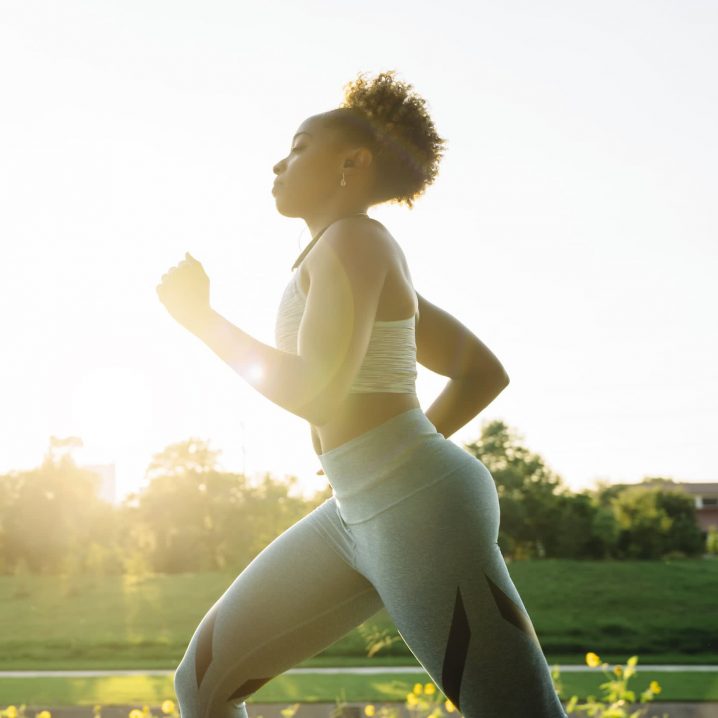
- POPSUGAR Australia
- Fitness
- What Could Be Behind Your Hip Pain While Running, According to Physical Therapists
What Could Be Behind Your Hip Pain While Running, According to Physical Therapists

After years of listening to my body during morning runs, long walks, and half marathons, I have a decent understanding of what’s behind my runner’s knee. And every 300 miles or so, my feet boldly remind me to add new sneakers to my shopping list, too. But, I consider myself completely lost when it comes to hip pain while running – which is unfortunate because I recently experienced that jarring and uncomfortable sensation while finishing up my jog a few weeks back, and it left me limping for a few days later.
Since hip pain doesn’t seem so cut-and-dry, I reached out to physical therapists for their thoughts on common culprits behind hip pain and running. Turns out, I wasn’t wrong – hip pain is complex, in that many different issues could be to blame. However, it is a common experience overall.
“Hip pain that occurs during running can come from several different sources, both within the hip joint as well as muscles surrounding the joint,” says Alyson MacKay, DPT, an orthopedic certified specialist and advanced clinician in physical therapy at HSS Hudson Yards in New York City. “Additionally, other body regions, such as the lower back, can refer pain to the hip region. Soft tissues, such as the tendons of the iliopsoas, hamstring, and gluteus medius and maximus muscles can generate pain.”
Jumping too intensely into a training regimen, overtraining, or poor mechanics could cause some of this hip discomfort.
“Stress fractures of the hip can occur with overtraining,” MacKay says. “The hip labrum, a tissue that helps to seal and secure the hip joint, can tear gradually in cases of hip impingement, which occurs during suboptimal mechanics or muscular strength deficiencies. As our joints, including the hip joint, age, we can develop osteoarthritic symptoms, including stiffness, loss of motion and pain.”
Related: 3 Expert-Backed Stretches For Runners Dealing With Achilles Tendonitis
Melissa Ling, PT, DPT, CSCS, of Bespoke Treatments Physical Therapy in Seattle, adds that since the hip is a large ball and socket joint, there could be many potential sources of pain. In addition to overtraining, like increasing mileage too quickly, or hip impingement, the hip pain could actually be caused by another issue in the body.
“The pain the runner is feeling may be the tensor fascia latae and IT band complex radiating down the front and side of the hip and thigh,” Ling says.
“Other complaints include pain in the back of the hip which could be caused by a spasming piriformis or an angry hamstring.” Ling adds that pain in the back, side, or front of the hip could be “manifestations of referred pain from the lumbar spine,” too.
Further proof that hip pain while running isn’t so simple, there’s also a chance that discomfort could come from a mobility issue, a strength deficit in the body, or a lack of flexibility.
“While the hip joint performs only a small range of motion during a run, it is important that the joint has the freedom to go through these ranges without impediment,” MacKay says. “Flexibility exercises may help maintain the motion that the hip requires.”
Related: Prevent Pain and Injuries on Your At-Home Bike With This Instructor’s Cycling Tips
Given that there’s so many potential explanations behind the aggravating pain of hip issues, Ling says that if your hip pain is impacting your running performance, seek a sports physical therapist’s opinion for tips on recovery, rehab, and retraining.
MacKay agrees that hip pain that impacts your activity should be taken seriously. “With an increase in running volume one of the more serious injuries we see is a stress fracture. The hip is a common site in which this can occur, and the primary treatment is a cessation of running and rest.”
If it’s just soreness that’s bothering you, Ling says that stretching and foam-rolling could be helpful – you can try some of Ling’s foam-rolling directions, below.
For each exercise below, roll about 2-3 inches up and down, then rotate side to side. Repeat for a total of about 30 seconds each side.
Piriformis:
- Sit on the floor, and place the foam roller underneath your hip along your glutes.
- Cross your ankle over your opposite knee.
Tensor Fascia Latae:
- Lie on your stomach, and place the foam roller on the front of your hip, just underneath the top of your pelvis.
- Support your upper body using your elbows and relax your legs.
Click here for more health and wellness stories, tips, and news.

